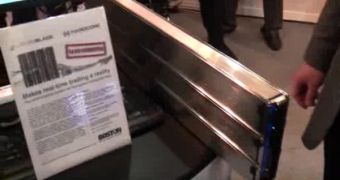At this year's International Supercomputing Conference (ISC), Supermicro has teemed up with Hardcore Computer in order to create a fully liquid submerged dual-socket server that is running overclocked Intel 'Everest' Xeon processors.
The whole blade server is housed inside a metal enclosure that is filled with dielectric liquid and is connected to a radiator and pump assembly.
Unlike the generic liquid cooling solutions that are used in high-performance desktops and workstation, this solution covers not only the CPUs installed the system, but also all the other components that are placed inside the chassis, including the Supermicro motherboard.
In a video interview with The Inquirer, Chad Attlesey, co-founder, president and CTO of Hardcore Computer states that this approach enables the company to overclock the two Xeon CPUs without having any thermal or voltage fluctuations.
According to the company rep, the result is that they were able to remove crashes and “bit failures” from the equation, thus enabling them to run the Xeon X5698 chips at 4.8GHz.
This is 400MHz more than the standard frequency of the Xeon X5698 processor, which happens to be the highest clocked Intel CPU ever released.
In order to achieve this frequency Intel had to disable four of the six cores available in the Westmere-EP architecture, but the company leaved the 12MB of the Level 3 cache memory intact.
The liquid cooled servers developed by Hardcore Computer are already up for grabs, and these are gaining in popularity among high-frequency traders at investment banks, where the latency of the computing systems used is extremely important.
This is not the first time that dielectric liquid was used for cooling servers, as Cray has also taken a similar route when it developed some of its supercomputers in 1980, but is however the first time that every single component inside a server is immersed in liquid.

 14 DAY TRIAL //
14 DAY TRIAL //